Five-Part Series on Visual Phasing:
- Part I – Explaining visual phasing and identifying/labeling recombination points (November 21, 2016)
- Part II – Assigning segments of DNA (November 22, 2016)
- Part III – Using cousin matches to identify which grandparent provided the segments
- Part IV – Mapping my own chromosome using the visually phased paternal chromosomes
- Part V – Using the mapped DNA with new matches
In “Visual Phasing: An Example (Part I),” we identified and labeled all of the recombination points in the three siblings, Susan, Brooke, and Felix:
In Part 2 of the series, we’ll use the identified and labeled the recombination points to assign segments of DNA to the four grandparents.
Step 3 – Fill in Chromosomes
The next step is to fill in the chromosomes using the identified recombination points. We’re going to start with the fully identical region shared by Susan and Brooke, shown in the red square in the next image. We can fill into both chromosomes for Susan and Brooke (the blue and purple segments):
Each of the blue and purple segments is one of the following segments: (i) paternal grandfather; (ii) paternal grandmother; (iii) maternal grandfather; or (iv) maternal grandmother. We’ll try to figure out which is which later.
We do know that a segment will continue until it reaches a recombination point. So we can extend Susan and Brooke’s segments outward in each direction to either the end of the chromosome or the next recombination point:
Susan’s segments have a recombination point directly to the right (the line marked “S”), but can be extended to the left all the way to the end of the chromosome. Brooke’s segments have a recombination point directly to the left (the line marked “B”), but can be extended to the right all the way to the end of the chromosome:
Now that we have Brooke’s entire chromosome to the right end, we can focus on the comparison of Brooke and Felix. As shown in the red square in the next image, Felix and Brooke share no DNA on the right half of the chromosome, from Felix’s recombination point to the end:
Since we know that Brooke’s chromosomes at that location are blue and purple, Felix’s chromosomes must be the two other colors we are going to use. Now we can fill those in, and we have all four colors (for paternal grandfather, paternal grandmother, maternal grandfather, and maternal grandmother, although we don’t know which is which right now):
But now we’re stuck. For the most part (except for the left end of Felix’s chromosomes, which are identical to Susan’s), the GEDmatch One-to-One comparisons don’t help us fill out the remainder of the chromosomes.
WARNING! Now comes the most confusing part of visual phasing!
This took me a while to figure out and become comfortable with, and it can be difficult to explain. Essentially, we have to make an arbitrary decision at this point, but this it the only arbitrary decision we can make. Once we make it, we’re stuck with our decision.This effectively cements a certain color combination as ‘maternal” and the other color combination as “paternal,” although I don’t yet know which is which.
Each of Susan, Brooke, and Felix experience a recombination event at this point. We’re going to chose one person, and one chromosome, to extend. Once we do that, the relationship of all the colored segments to each other is fixed, and we won’t be able to arbitrarily decide which chromosomes to extend from the other two people.
So we have to extend a chromosome at one of the following red arrows:
KEY TIP: This decision point is a good place to come back to if you think you’ve made a mistake, or if the chromosome you decided to extend wasn’t helpful. For example, in the image above, extending Brooke’s segment and finishing her chromosomes might not allow us to complete the entire puzzle.
For example, let’s extend Felix’s chromosome gray chromosome, which means that the green segment has the recombination point and switches to the complementary color, purple. We can extend both of those out to Felix’s next recombination point:
Before that decision, purple could have been either paternal or maternal, and blue could have been either paternal or maternal. They were interchangeable. Now, however, although we still don’t know which is which, we know that the purple and green chromosomes underwent recombination in either the mother or father at that point.
So we can’t arbitrarily decide which segments to extend in Brooke and Susan, instead we have to go back to the GEDmatch One-to-One comparisons.
We see that Brooke and Felix share on both chromosomes in the region shown by the red box in the next figure:
Since we know what Felix’s chromosomes ‘look’ like at that region, we can fill in Brooke’s chromosomes at that region, and we know which extends and which experienced recombination. And, we can extend that out to the end of Brooke’s chromosome:
We’ve now finished Brooke’s chromosome entirely!
We see that Susan and Felix share on both chromosomes at the region shown by the red box in the next figure:
So we can fill that out for Felix:
We’ve now finished Felix’s chromosome entirely!
We see that Susan and Felix share NO DNA on either chromosome at the region shown by the red box in the next figure:
So we can fill in that region for Susan, using the colors opposite Felix at that region (Felix has gray and purple, so Susan must have blue and green), and we can extend that all the way to the end of the chromosome:
We’ve completed all three chromosomes!
Now, note that I intentionally selected a chromosome that I could complete fairly easily. It is VERY common to not be able to solve an entire chromosome. Sometimes it can be solved by bringing in another sibling or cousin matches, but even then sometimes it cannot be completely solved. And that’s fine, you can work with a chromosome map that isn’t completely solved.
I know that blue and gray are one side of the family, and that purple and green are the other side of the family. But I don’t know, yet, which is which. In the next part, we’ll use cousin matches to deduce which combination is maternal and which is paternal, and hopefully we’ll determine which segments belonged to which grandparent.
NOTES/TIPS:
- VERY IMPORTANT! Each chromosome is its own individual project. The color combinations can be completely opposite from one chromosome to the next. Here, where blue/gray might mean maternal, they might mean paternal in the next chromosome. Once I determine the source, if I can, I’ll change around the colors to be consistent from chromosome to chromosome. But think of each chromosome as its own project, do NOT carry other preconceptions about colors to the next chromosome!
- We can already make some interesting conclusions here:
- For example, we see that the entire blue, gray, and purple chromosomes are represented in these three siblings. The green chromosome is not, however. So if there are no other siblings, that green chromosome from 0 Mb to 29 Mb has been lost to all descendants.
- As another example, only Felix inherited DNA from all four grandparents on chromosome 21. Brooke and Susan only received DNA from three grandparents, and mostly from the purple and blue grandparents!
- Eventually, I would like to be able to tell a computer program to recreate the blue and gray chromosomes in a new file in their entirety for the first parent (either mother or father), and to recreate the entire purple and partial green chromosomes in a new file for the other parent (the other of the mother or father).
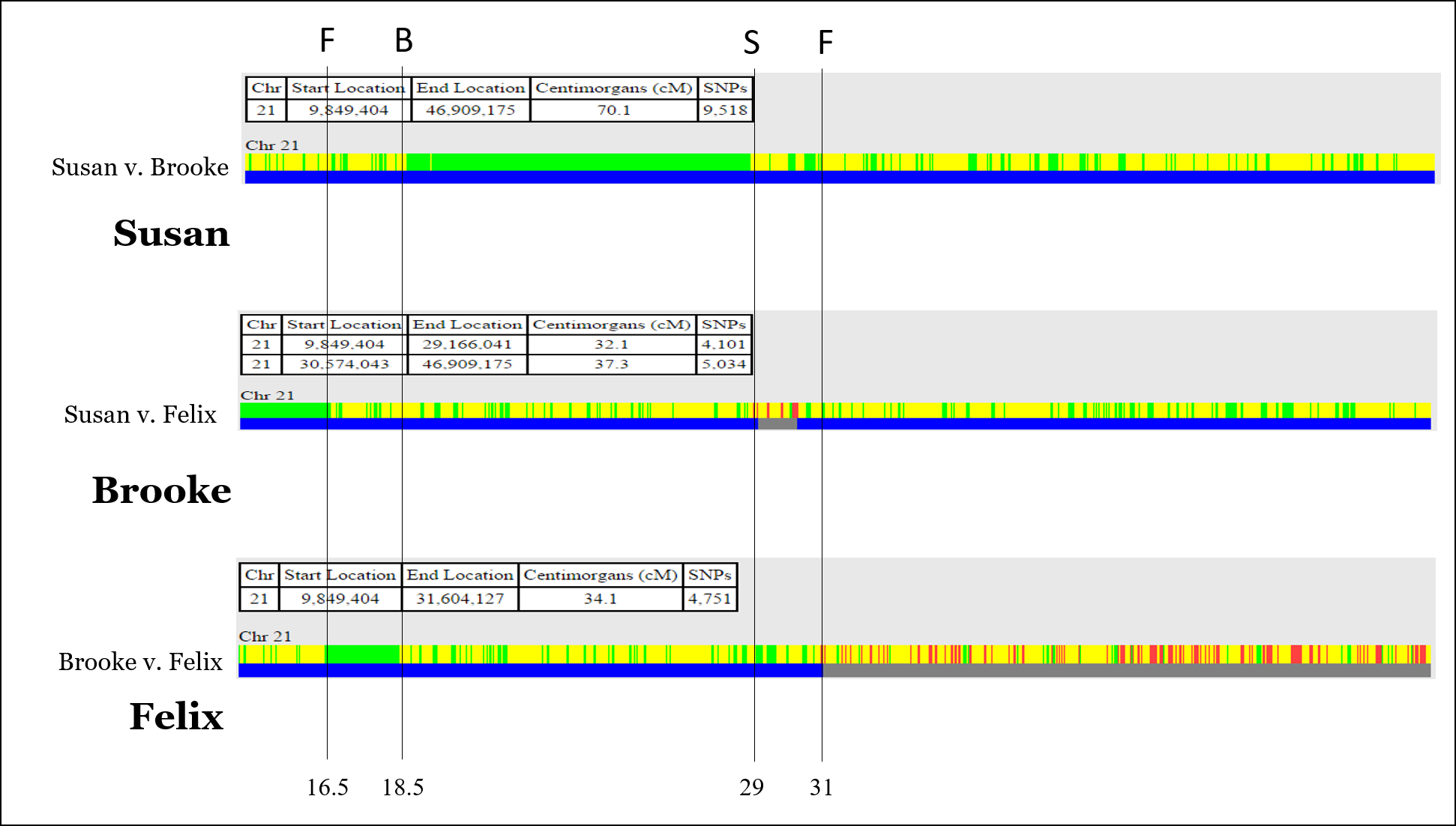

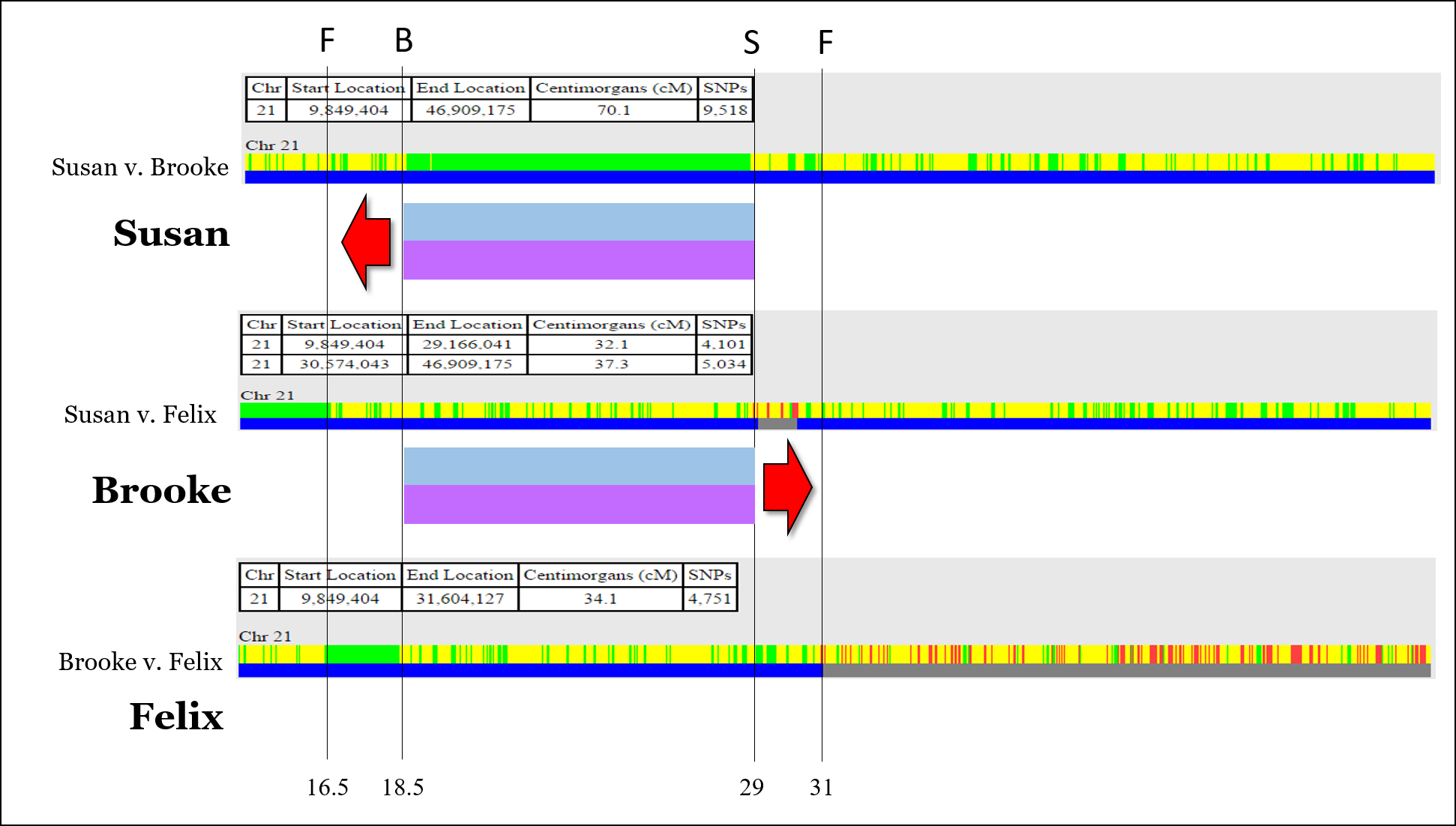
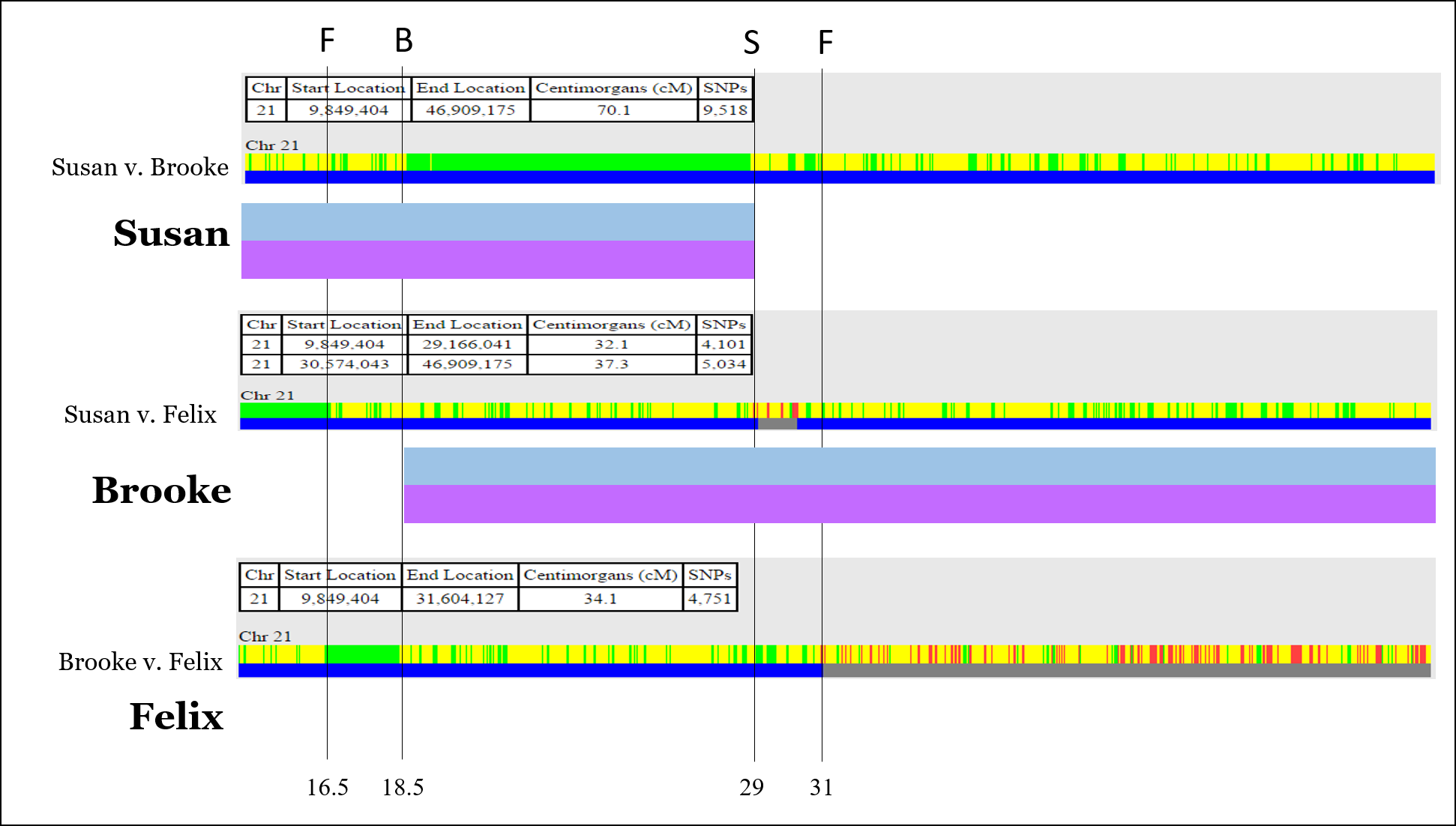
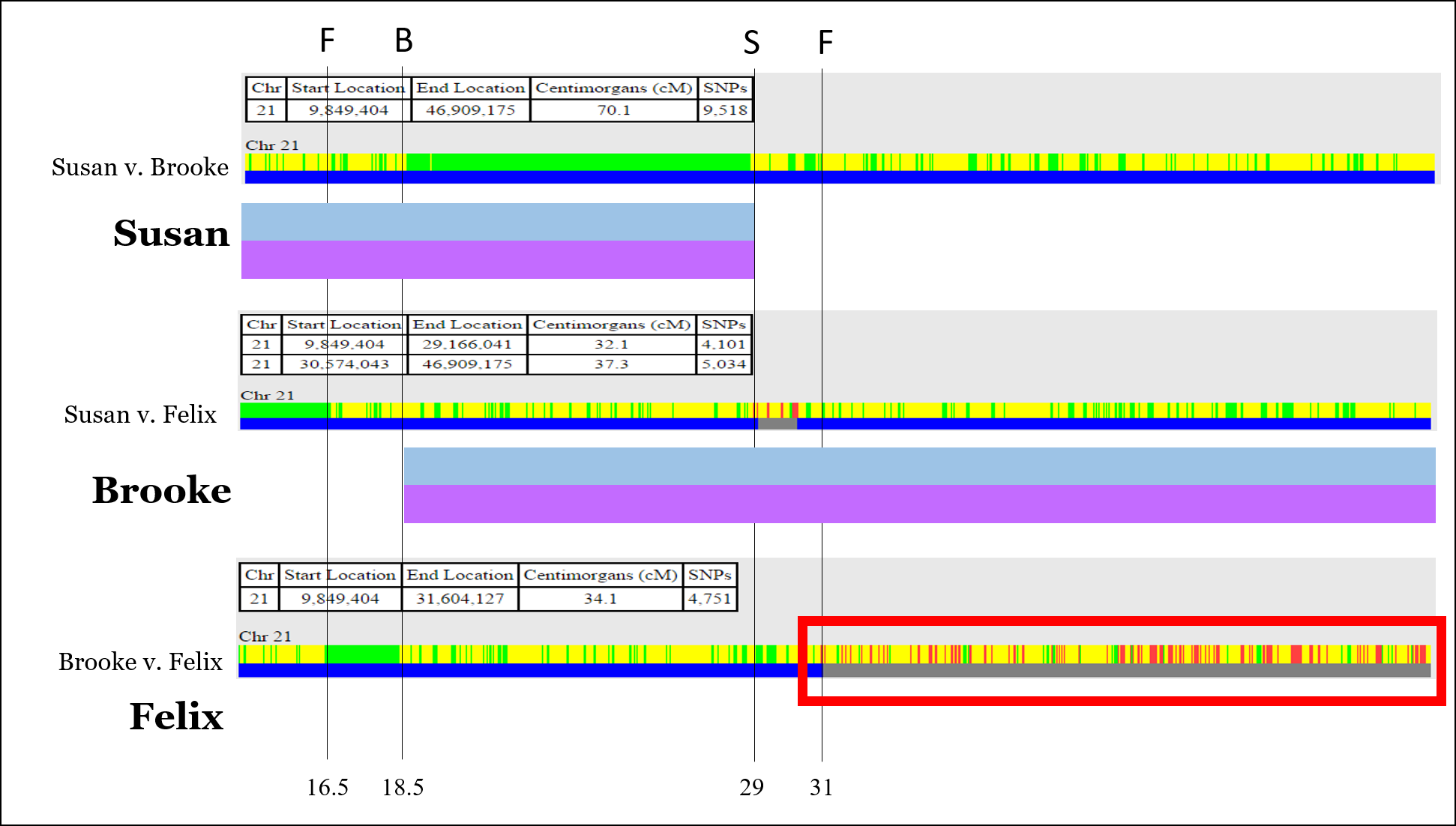
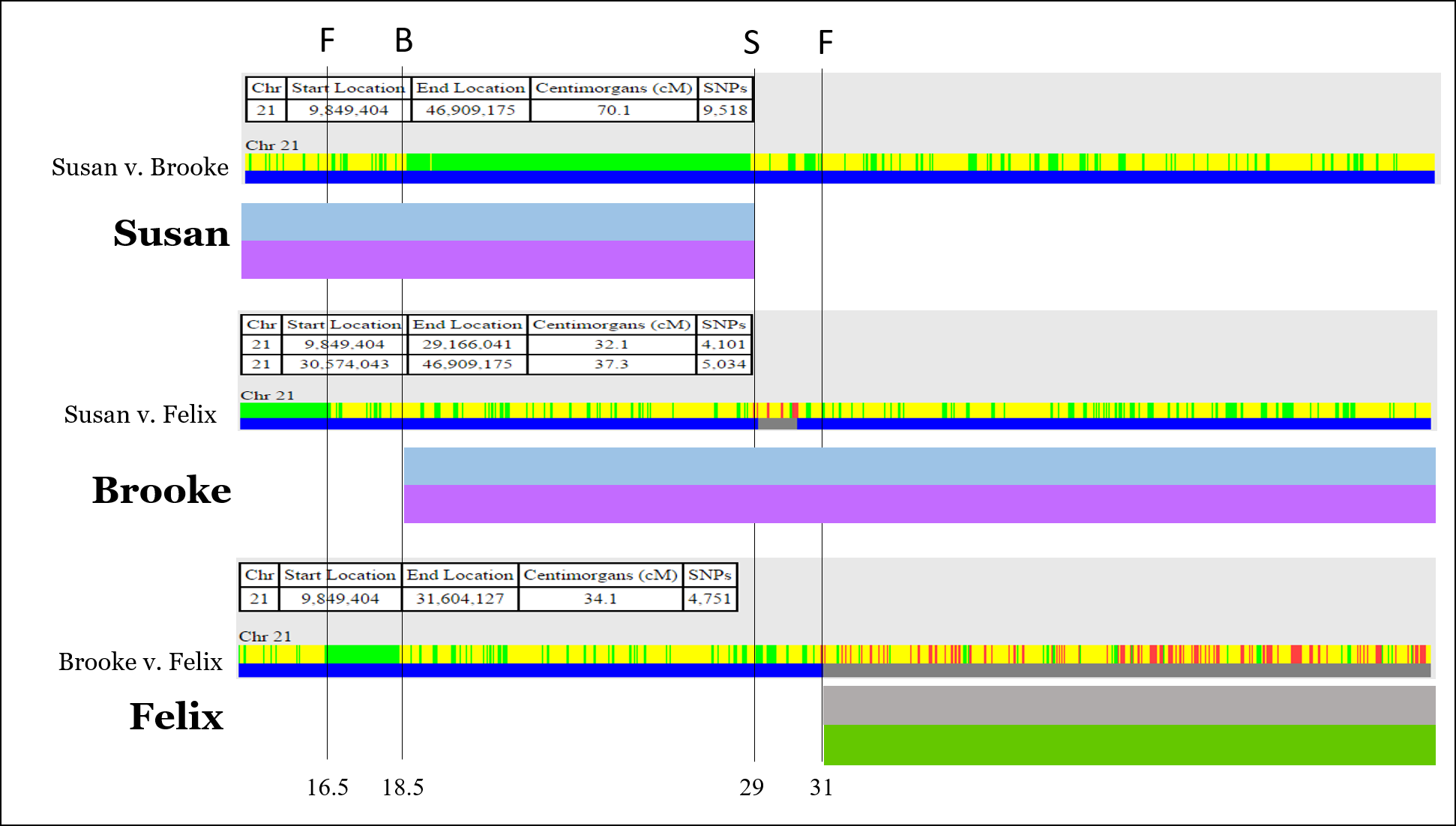
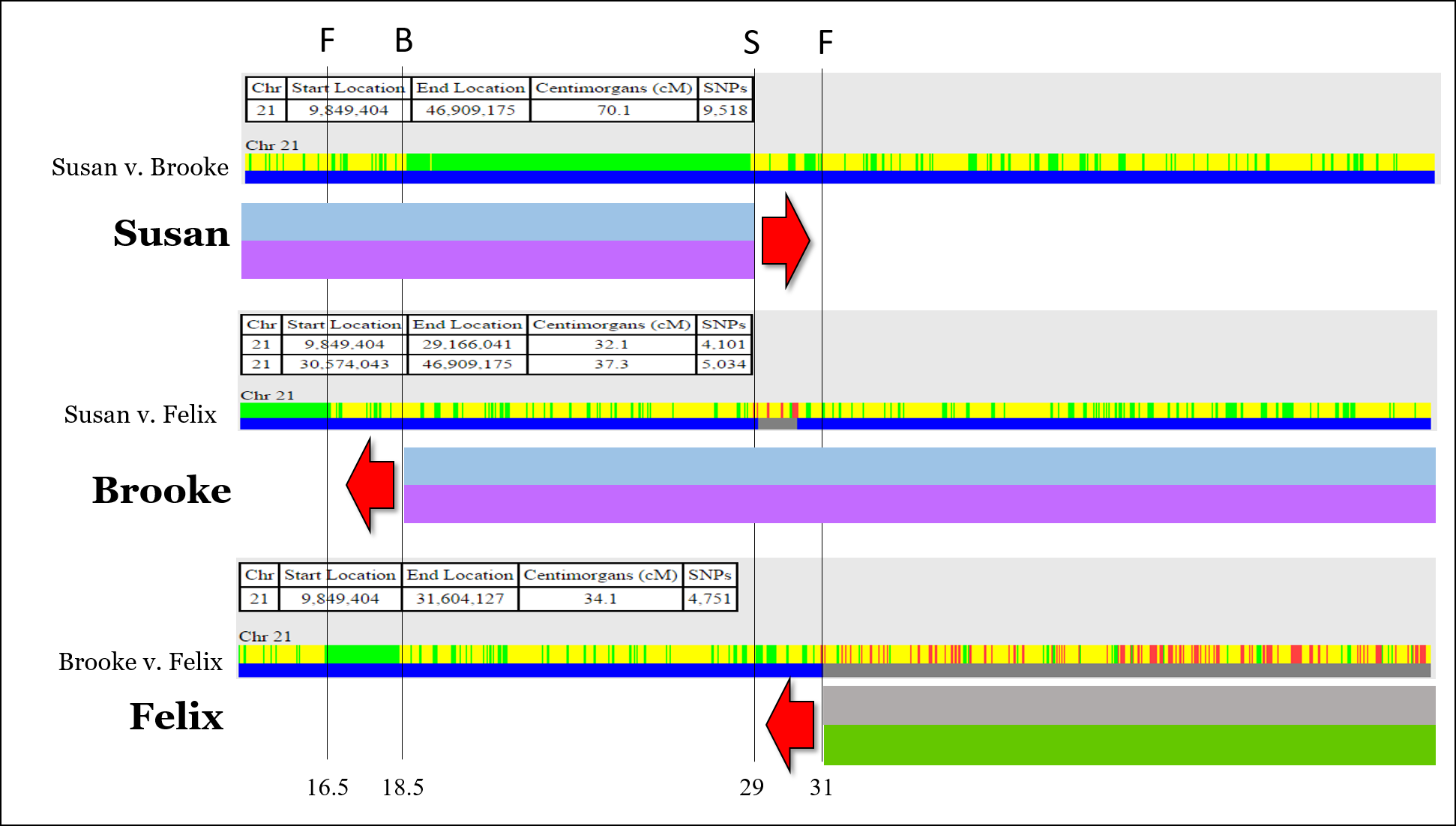
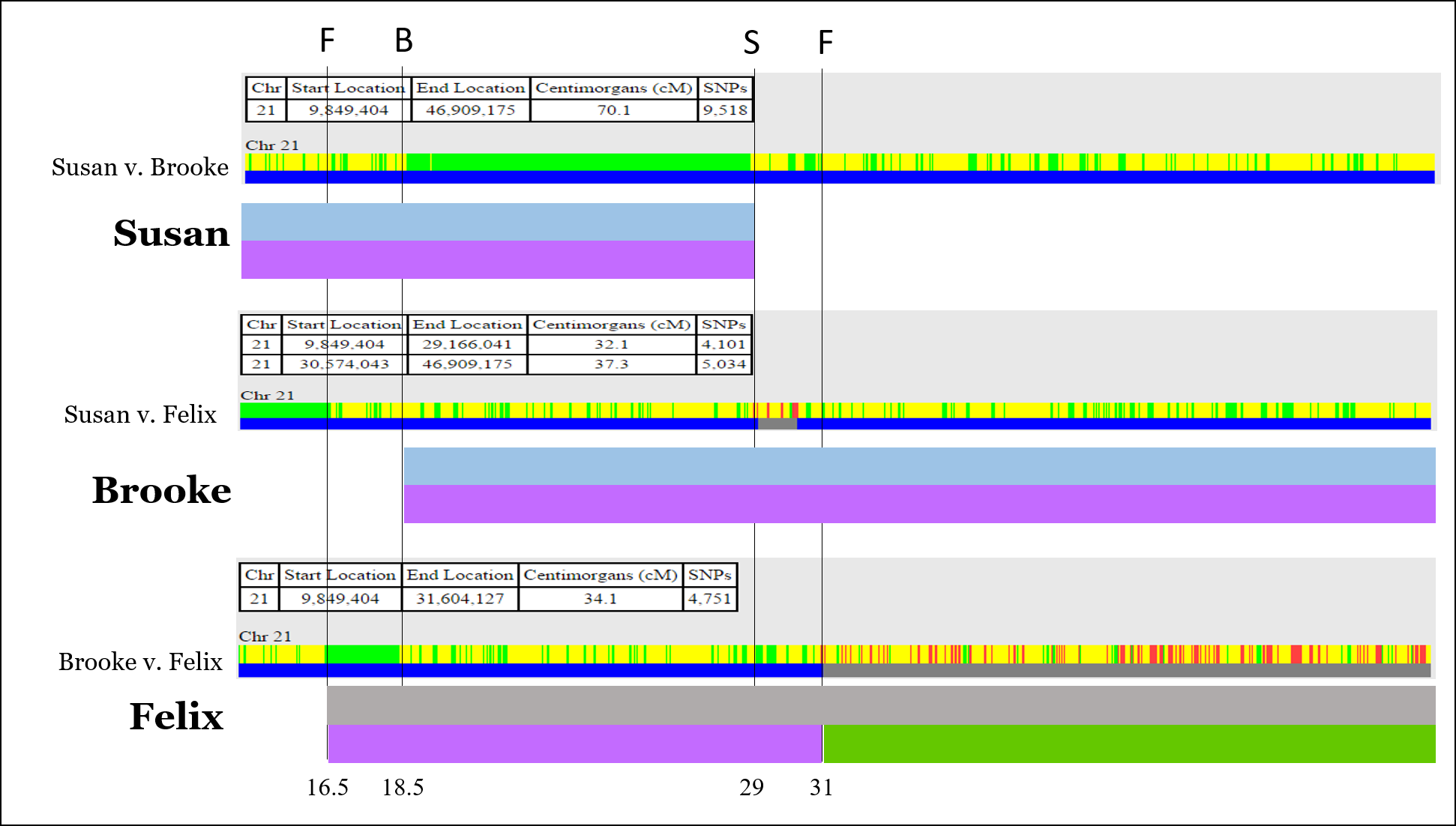
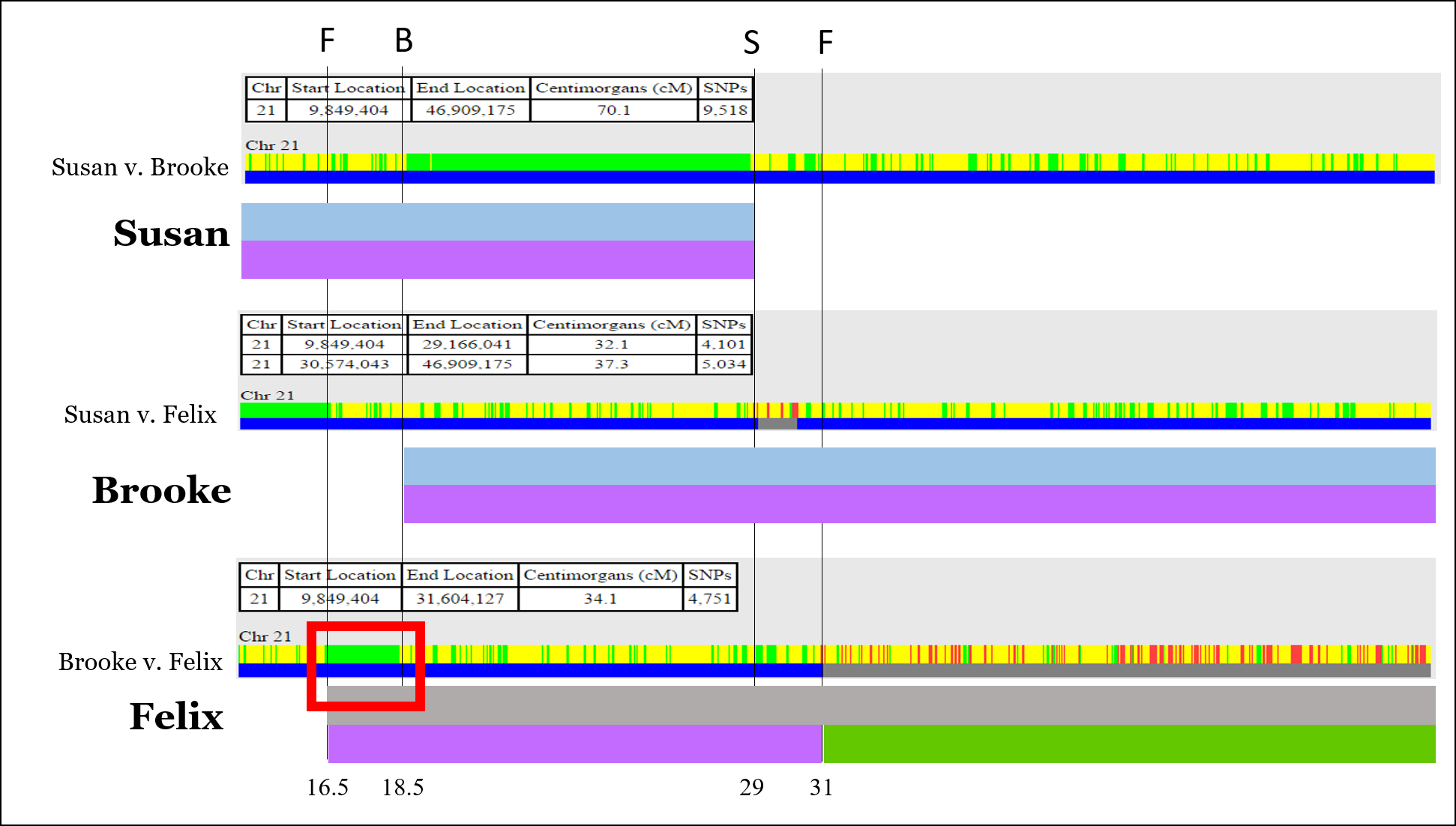
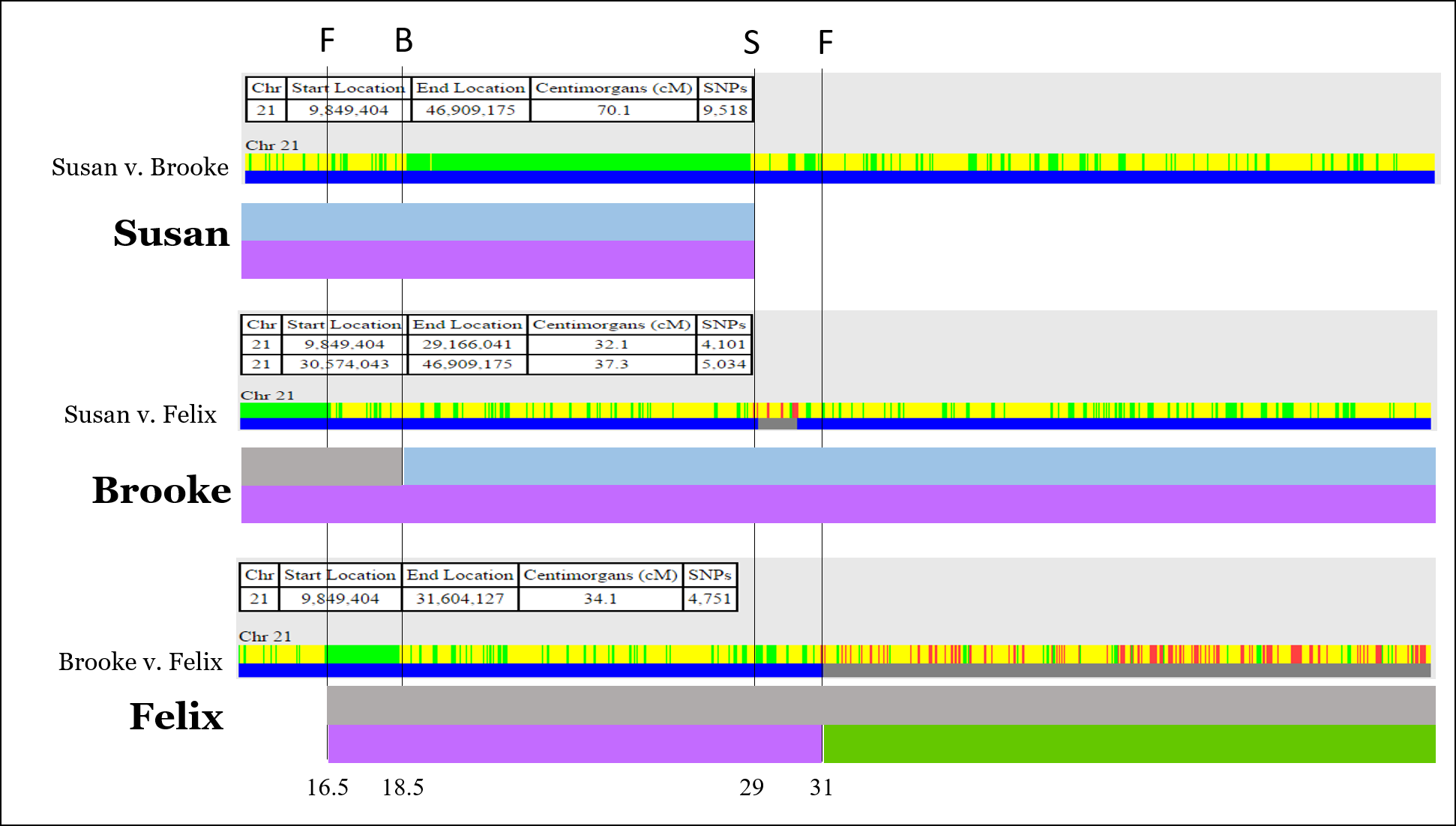
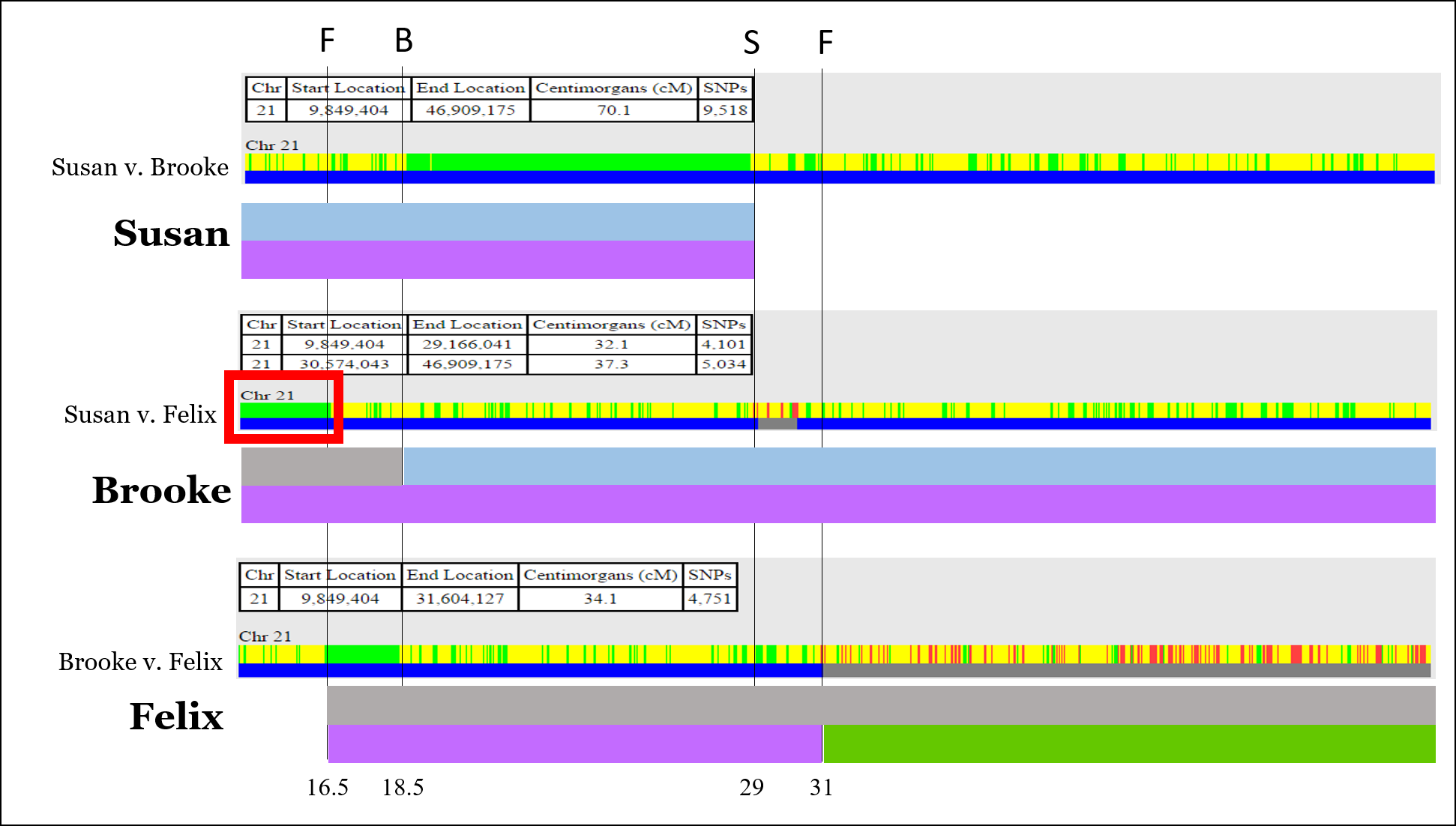
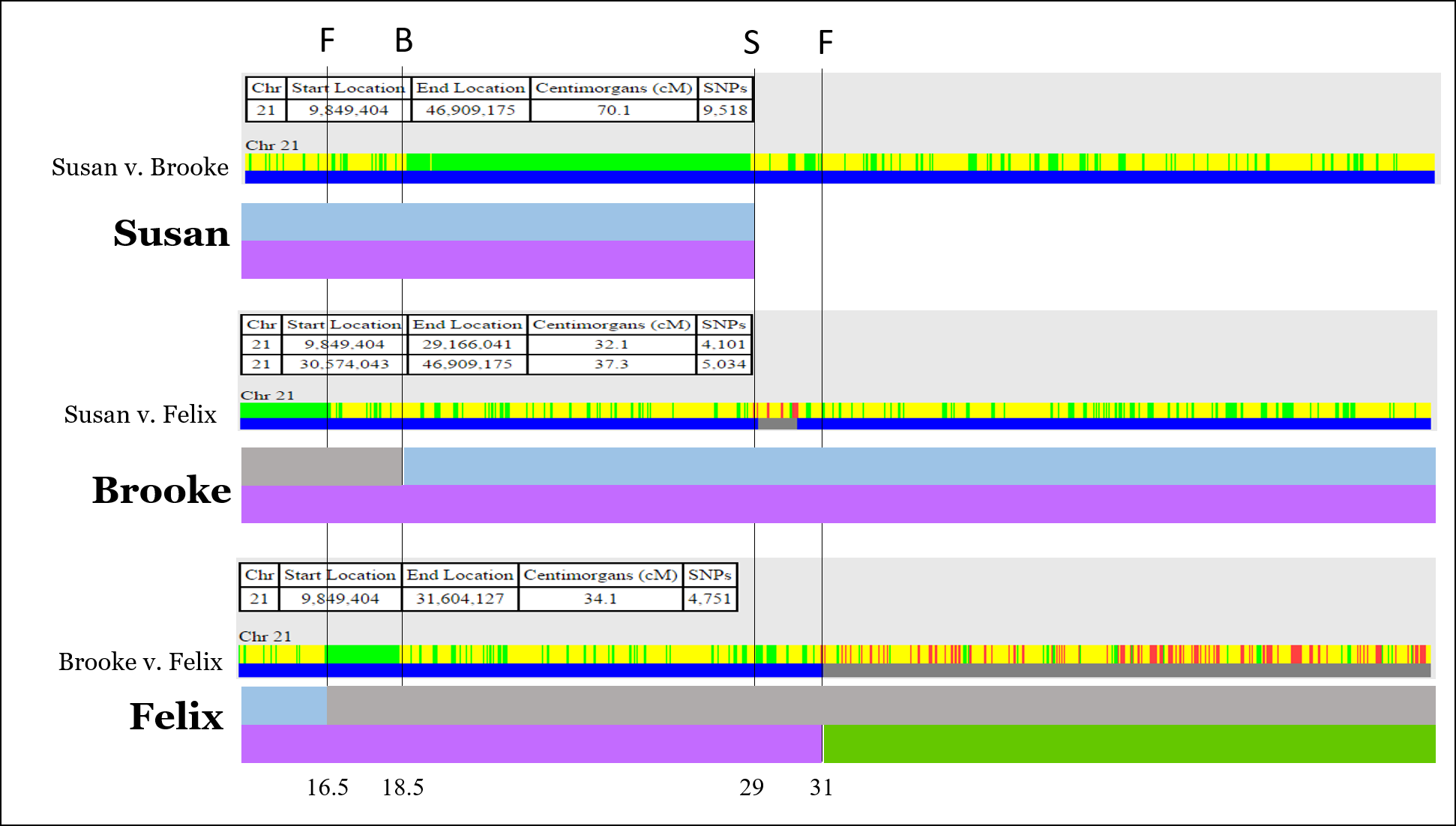
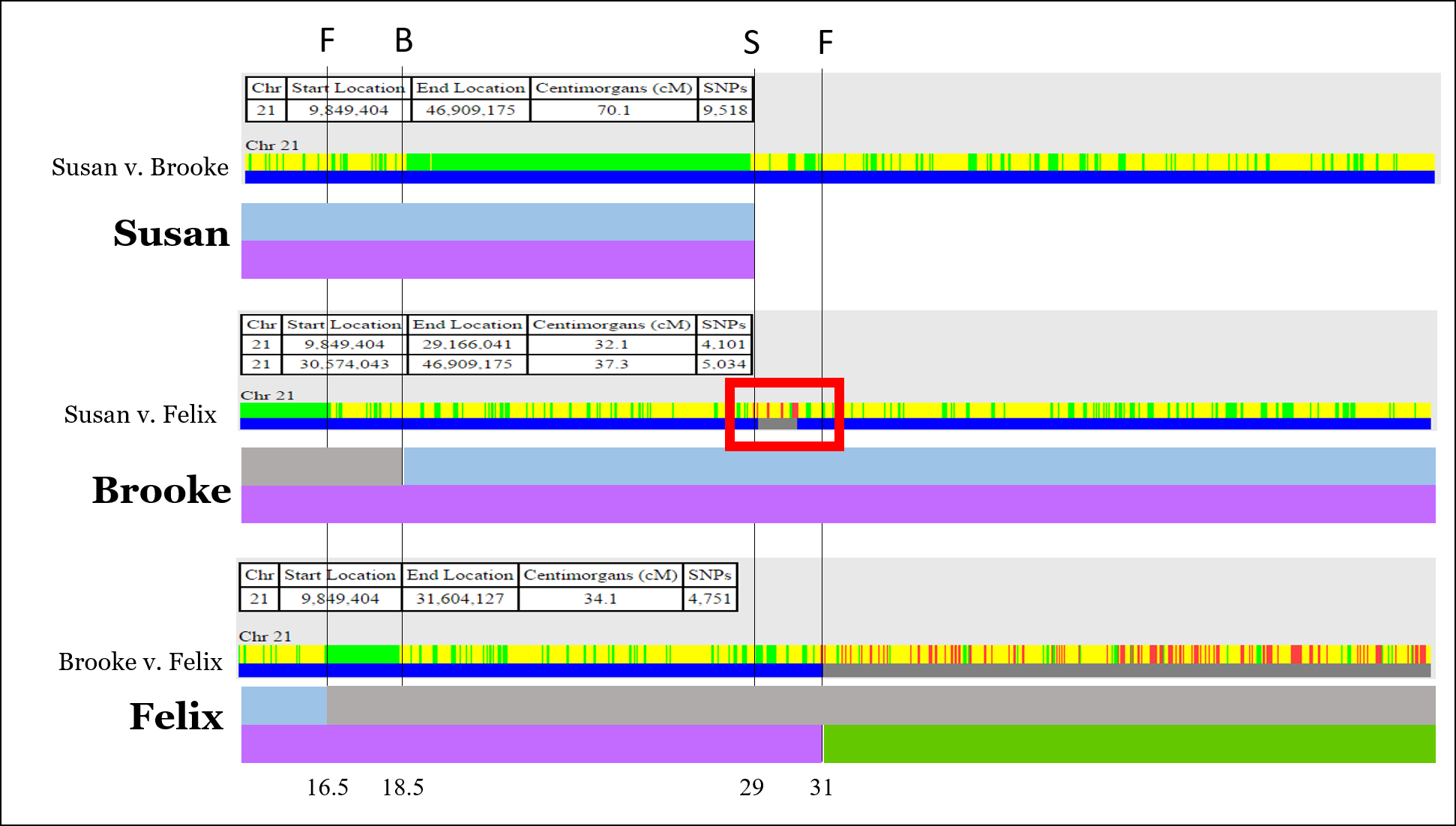
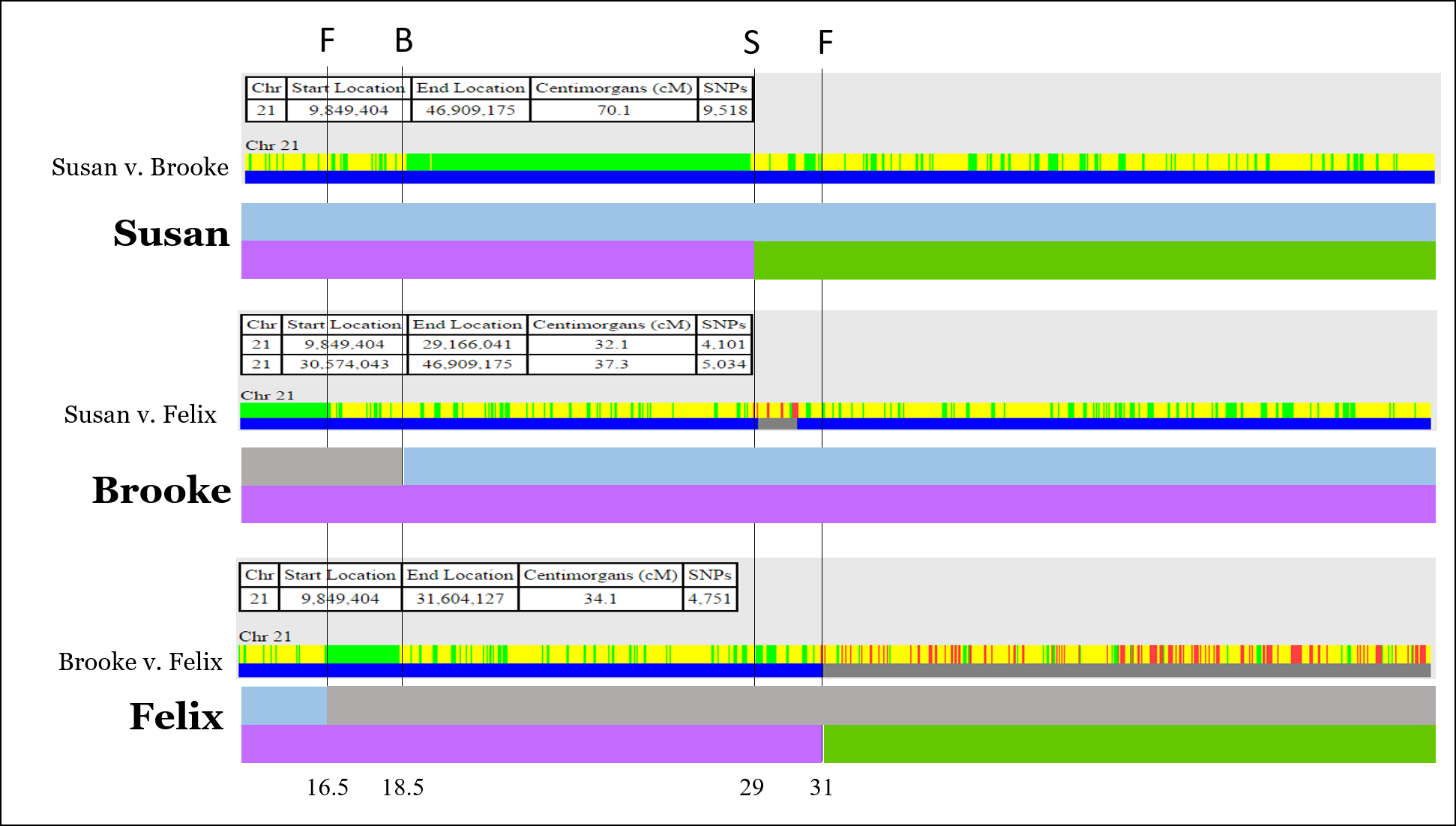
Another great post Blaine! Your warning was spot on — when I got to that point I was a little confused and had to just sit and stare at it for a while. I found it helpful to make a copy of the slide at that point so that if I went down the wrong path I had a good starting point to go back to without having to undo all the wrong moves.
On the first one I tried, I got a result similar to your example — my brother and I only got DNA from 3 of our 4 grandparents while my sister got some from all 4. Both my brother and I got an entire chromosome from a single grandparent (not the same grandparent), and 2 of the 4 chromosomes were not represented completely across the 3 of us.
You’ve got me hooked — this stuff is fascinating! I look forward to the next step.
Great Mike! I think this process has great potential for those of us that don’t have grandparents tested!
Blaine, I’ve been using this technique, and I have run across two situations where I am not sure what to do when assigning the segments.
(1) I have a few instances where it is not clear who owns a recombination point — when looking at the graphs for all three pairwise comparisons it looks like there is a change for all of us. Any guidance on what to do?
(2) I have run across some instances where it is not clear which color segment to extend at a recombination point; either color could work, and looking at cousin matches doesn’t clarify the situation. Seems like it happens most often at the end of a chromosome.
I realize these questions may not exactly be clear; I can provide some examples by e-mail if that would help.
Thank you for your posts on this. Have you seen situations where one of the siblings does not have a recombination point on one of the chromosomes?
Susan v Brooke=Susan
Susan v. Felix=Brooke
Brooke v. Felix=Felix
I am not sure why the names were assigned to the pairs I can’t figure out why Brook was assigned to the Susan v. Felix comparison. So it’s throwing me. I also started with an X and realized I would only have 3 grandparents since the sibs are 2 girls and a boy. I think I can safely assume where the boy does not match the 2 girls (who fully match), he is carrying his paternal grandmother’s DNA and the girls the DNA from both maternal grandparents. I think figuring out which name is assigned to the comparisons might help me figure out what to do at the warning point above to extend the line. Any insights?
You can just ignore where Susan, Brooke, and Felix were placed; that’s the methodology I use. You could put them anywhere. In fact, some genealogists put them all below the three comparisons, which also makes sense.
Sounds like you’re on the right track with the X!
I’m missing a point. Right after the “Warning” section, when the decision is made to extend Felix’s chromosome to the left (beginning), “to Felix’s next recombination point”. Isn’t there a recombination point at both 16.5 and 18.5? This is depicted in the Part 1 post. Why is the extension taken all the way to 16.5, versus stopping at 18.5?
The reason you paint through 16.5 to 18.5 is because you stop at the next recombination point that Feix “owns”. He owns the 18.5 point but not the 16.5 point therefore he can paint all the way to 18.5 Hope this adds clarity.